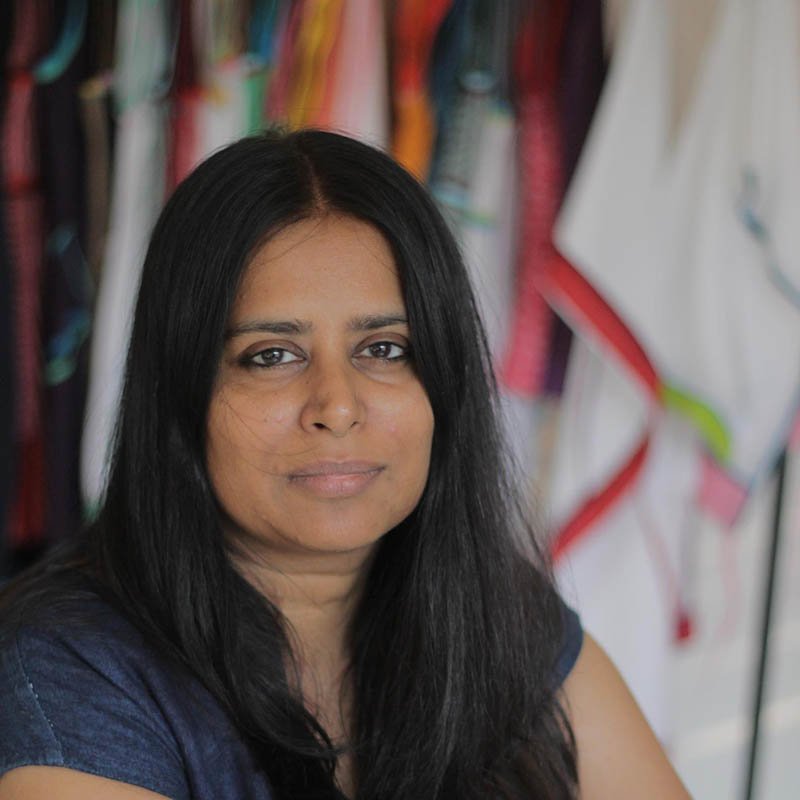Gitika Goyal
UCRF is running a ‘Member of the Month’ feature on this blog, where a member, selected at random from the membership database, is sent five questions to give us all an overview of our members. Our seventh participant is Gitika Goyal.
– How would you sum up your research / practice?
I am a designer, entrepreneur and teacher. As a designer & entrepreneur, I have practiced slow fashion from the time I started my design company in the late ‘90’s. I don’t think the term was coined then. More recently, I have introduced circular fashion in India through my domestic brand.
FIT New York set up NIFT, the first Design School dedicated to fashion in India in the late ‘80s and I was fortunate to be a part of the second batch which graduated in 1990. I have always been very good with my hands – draping, cutting and making clothes was something I naturally took to. I had found my passion and continue to be hands-on even today.
However I came of age only a few years later and my life took a turn. Sustainability and slowness in fashion became deeply integrated in my work, as a result of working in a beautiful space called Anokhi and teaching at NID. In 1998 I created my design company, CUT ONE.
These are 3 brands that I have created over the years:
1. Gitika Goyal – 1998
Premium sustainable fashion and home decor, exported to UK & Europe and retailed through niche concept stores.
2. Gitika Goyal Home – 2011
Premium sustainable home decor, exported to the US and retailed mostly through online stores.
With both these premium brands, there has been a quietness in my ways with no frenzy of marketing – social or otherwise. For me the motivation has been to stretch my creative boundaries (as opposed to an unending pursuit of money). Business has moved through trust and recommendations at a pace that has worked out well for me.
3. GRASS by Gitika Goyal – 2017
An online brand of eclectic, easy & affordable women’s fashion. With this brand, I have introduced circular fashion in India.
Teaching for me, has been a way of articulating and imparting what I have learnt in my practice, getting exposure to the latest ideas & techniques developing in the world and then applying it in my practice as well. It has also allowed me to further develop my thoughts and understanding that I would otherwise not have the time to do.
I have been a faculty at these design schools:
Srishti School of Art, Design & Technology, Bangalore 2003-2005
National Institute of Fashion Technology (NIFT), Gandhinagar 1997
National Institute of Design (NID), Ahmedabad 1993-1997
Being inducted on the UCRF board has been a huge honour and I can see the rest of my life dedicated in creating awareness, educating and working diligently towards this cause.
– How do you address fashion and sustainability in your work?
From 1998 onwards, the sustainability practices that I’ve followed consistently are – slow fashion, holding minimal inventory, very little waste & recycling, use of only natural & biodegradable cotton & wool fabric, use of hand-spun & handmade khadi fabrics and sustaining traditional practices of hand embroideries, hand quilting etc. (extending them into a modern, contemporary form). With my new domestic brand, it has also become possible for me to practice repairs & maintenance, exchanges and circularity.
– What are the conflicts you have encountered around fashion and sustainability in your work?
I wouldn’t say that I have encountered any conflict in my work, I always went ahead and did what felt right to me. However, the thing that surprises me the most is how people do not question growth as the only model to live by. When a Company goes from 30 million to 300 million to 3 billion, I wonder if it’s blindly driven or if there is a conscious questioning there. Ironically enough, Covid 19 has shown us that we need very little to actually survive.
– What do you consider the key sources and cases when it comes to fashion and sustainability?
Being born in India has been the best exposure to a way of life that is sustainable at it’s very core. Additionally being at NID and teaching there, gave me the exposure to sustainable practices applied in other design disciplines around the world. This became the source and foundation for my work in sustainability in fashion.
– Could you recommend some less known sources or cases you think should be more widely shared?
Goonj is an NGO in India which has done exemplary work in the field of Circular Economy, moving clothing from urban spaces to rural and to the poor in a beautifully synergised way.
Thank you very much for your insights Gitika!

